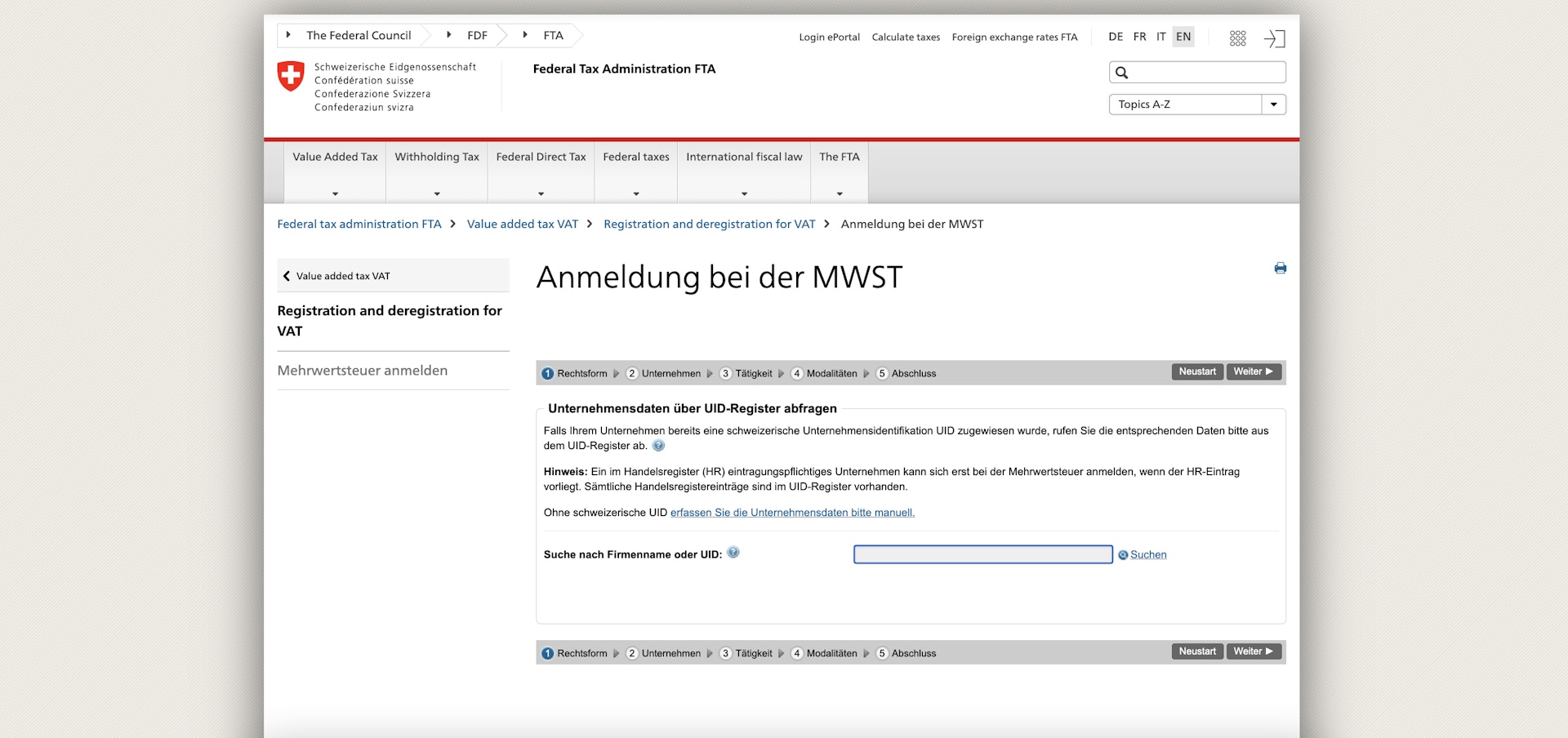VAT is an important part of the Swiss economic system. Companies charge it on their products or services. This article explains why it exists, how it works and what you need to consider when paying Swiss VAT.

What is VAT?
VAT is used to support the Federal Government in covering its general expenses. Companies which sell products or services and which have a turnover greater than CHF 100,000 per year are obliged to submit VAT to the Federal Government in Switzerland. Companies charge VAT when selling their goods or services to end customers.
What are the applicable VAT rates in Switzerland?
The following VAT rates currently apply in Switzerland:
VAT rate | Percentage of turnover until 31/12/2023 | Percentage of turnover as of 01/01/2024 | Applicable on |
Standard rate | 7.7 % | 8.1 % | most products and services (e.g., clothing, electrical appliances, hairdresser's, restaurant dining) |
Special rate | 3.7 % | 3.8 % | Hotel accommodation |
Reduced rate | 2.5 % | 2.6 % | Daily necessities (including food, soft drinks, books, newspapers, magazines, medication) |
How is VAT paid?
All companies liable to pay VAT must pay their VAT to the Swiss Federal Tax Administration (FTA). The most important concepts which need to be clarified to pay VAT are:
- Agreed or received remuneration
- Net tax rate or effective method
Agreed compensation or received remuneration
Every company must decide on whether it pay VAT based on agreed or received remuneration:
- Agreed remuneration: The standard procedure of the Swiss Federal Tax Administration (FTA). VAT is due as soon as the company invoices its services. The company may have to pre-finance VAT if, for example, the customer pays the invoice in the next billing period.
- Received remuneration: VAT is only due upon receipt of payment, i.e., once the customer has paid the invoice.
In professionally managed financial accounting with general ledgers and subledgers, the agreed remuneration method makes the most sense. Lack of payment, by insolvent customers for example, is taken into account in this standard procedure through derecognising receivables. This method, therefore, does not disadvantage the company.
If a small business owner or self-employed person only records outgoing and incoming payments, they can use the received remuneration variant. This means they do not need to pre-finance VAT. An application to use this method must be submitted to the Swiss Federal Tax Administration (FTA) via a special form.
Net tax rate or effective method
A decision must also be made on one of the two VAT payment methods:
- VAT payment with net tax rate: Many small businesses rely on the net tax rate method when paying VAT as it minimises administrative complexity: On the one hand, VAT need only be paid each semester – instead of quarterly as with the effective method. On the other hand, no input tax is determined when using the net tax rate.
- Effective VAT settlement: In the case of effective VAT settlement, companies must declare the turnover achieved and the input tax incurred. The above-mentioned tax rates are used. Companies subject to effective taxation submit an invoice to the Swiss Federal Tax Administration (FTA) every quarter. The deadline is 60 days after the end of the quarter. The same deadline also applies to payment.
Detailed explanation of the net tax rate method
When settling VAT using the net tax rates (SSS), tax liability is as follows: The turnover (including the VAT charged to the customer) is multiplied by the net tax rate. The Swiss Federal Tax Administration (FTA) must approve this lower VAT rate, with this being dependent on the company's sector. The advantage of this method of paying VAT is obvious: The input tax is paid at a flat rate and need not be paid in an itemised manner.Whether or not a company can pay using net tax rates depends on its taxable annual turnover, with the company also being bound to a maximum annual tax liability. The Swiss Federal Tax Administration (FTA) must also be notified that VAT is being officially paid with net tax rates. Learn more about the conditions for using the net tax rate method.
Registering for VAT
A newly founded company expecting an annual turnover greater than CHF 100,000 must first apply for a VAT number from the Swiss Federal Tax Administration (FTA) – the easiest way to do this is by using the FTA's online portal for VAT registration.
Companies with a turnover of less than CHF 100,000 are exempt from taxation. They can, however, voluntarily register for VAT. This is because: Companies with a lower turnover are entitled to deduct input tax – registering for VAT is particularly worthwhile if larger purchases are pending.
Submit VAT invoices online
The next step – actually settling the VAT – is carried our via the FTA's online portal for paying VAT.
Anyone who has paid VAT with FTA SuisseTax in the past must integrate their data into the new portal – the FTA provides instructions for doing this.
bexio software makes this even easier. We'll show you why.
Paying VAT in bexio
Would you like to easily pay your VAT? Then work with accounting software like bexio and handle your accounting online: The software automatically displays the form in a manner compliant with the settlement form of the Swiss Federal Tax Administration (FTA). Whether you pay your VAT using the effective or the net tax rate method, based on agreed or received remuneration: bexio will support you with either method/variant.
bexio automatically updates the VAT form with every transaction. All required information and figures, such as total turnover of the various rates, are included in the bexio form. This allows you to easily transfer the figures and keep on top of paying your VAT.

What is input tax and how do input tax deductions work?
The term input tax refers to VAT paid by a company when it purchases goods or services. It is entitled to deduct input tax when doing this. This means it can offset the VAT which it collects from its sales against the input tax from purchases it has already paid.
If the company pays more input tax than VAT it has accumulated, the tax office will refund the corresponding amount of input tax. If, on the other hand, accumulated VAT from the company's sales is greater than the input tax paid on purchases, the company must pay the difference to the tax office.
An example:
- A customer purchases a table from a carpenter for CHF 216. This includes CHF 16 in VAT which the carpenter must pay to the tax office.
- The carpenter purchased the wood for the table from a timber retailer for CHF 100 plus CHF 8 VAT.
- He can now deduct this CHF 8 in input tax from the 16 CHF which he owes to the tax office. In this example, the carpenter therefore "only" pays CHF 8, or 4 % VAT, for the order.
Frequently asked questions about VAT
The Swiss VAT obligation applies to natural and legal persons domiciled in Switzerland. Both individuals and companies whose professional or commercial activities are aimed at generating income are generally liable to pay tax.
Foreign companies which record income in Switzerland may also be liable to pay VAT in Switzerland. However, these as well as associations and non-profit organisations are subject to special regulations:
The point at which a company or person in Switzerland becomes liable to pay VAT is dependent their annual turnover: If this is greater than CHF 100,000, the company must pay VAT. Companies with a lower annual turnover are exempt from this obligation. A company's legal form (for example, GmbH, AG or sole proprietorship) has no bearing on liability to pay VAT.
The VAT number is composed of the UID with the suffix "MWST". It's format is CHE-123.456.789 MWST. The UID (company identification number) is a unique, overarching number allocated to all companies active in Switzerland by the Federal Statistical Office (FSO). It can be found in the FSO's UID Register. The UID has entirely replaced both the 6-digit VAT number (e.g., MWST 123 456) and the 11-digit commercial register number (e.g., CH-320.3.074.699-6).
Normally, VAT must be paid within 60 days after the relevant billing period has elapsed. The corresponding form must be submitted to the FTA without this being requested. However, VAT deadline extensions can often be arranged.
If a company completely ceases its activities, it must deregister from VAT. The VAT deletion from the FTA must be carried out in writing within 30 days following cessation of business activities.
If annual turnover permanently falls below the limit of CHF 100,000, the company can deregister from VAT – no earlier than at the end of the tax period in which it ceases to reach the turnover for the first time. In this case, a deregistration period of 60 days after the end of the tax period applies. If no deregistration is carried out, this will be considered a waiver of exemption from VAT liability and VAT must continue being paid to the Federal Government.
Test out bexio now for 30 days free of charge and with no obligation
Test all the features of bexio, the simple business software for your SME administration.





